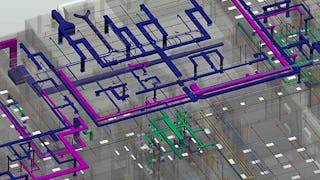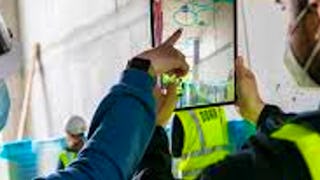In this course, we will explore the foundational principles of Building Information Modeling (BIM) and its practical applications, starting with the evolution of engineering from traditional 2D drawings to the shift towards object-based modeling, which forms the core of BIM. This understanding sets the stage for examining real-world implementations across diverse sectors including airports, residential and commercial buildings, water treatment plants, substations, transportation, and material handling facilities. We begin with BIM fundamentals through case studies demonstrating its role in enhancing efficiency and collaboration in complex projects. Moving forward, our focus shifts to Design Authoring workflows aligned with ISO 19650 standards, preparing participants for hands-on experience with Autodesk Revit. We explore Revit's user interface comprehensively, covering menus, ribbons, and key concepts such as Revit extensions, parameters, worksets, phases, design options, schedules, annotations, and sheet creation. Finally, participants delve into practical BIM modeling within Revit across architecture, structural, and MEP disciplines, equipping them with essential skills to create detailed and integrated BIM models across disciplines. Join us on this journey to master BIM fundamentals and discover its transformative potential in engineering and construction.

Genießen Sie unbegrenztes Wachstum mit einem Jahr Coursera Plus für 199 $ (regulär 399 $). Jetzt sparen.

BIM Fundamentals for Engineers
Dieser Kurs ist Teil von Spezialisierung für Building Smarter: BIM in Practice

Dozent: Subject Matter Expert
9.313 bereits angemeldet
Bei enthalten
(102 Bewertungen)
Empfohlene Erfahrung
Was Sie lernen werden
Learn the fundamentals of BIM, including creating 3D models and using isometric views to enhance project efficiency and collaboration.
Use specific modeling techniques for architecture, structure, and MEP, adhering to ISO 19650 standards for managing Work In Progress (WIP).
Learn the basics of Autodesk Revit, Revit Architecture for building design, starting with file setup and modeling architectural elements.
Use Revit MEP for mechanical, electrical, and plumbing design, including HVAC, plumbing, piping, fire protection systems, and electrical lighting
Kompetenzen, die Sie erwerben
- Kategorie: Engineering Documentation
- Kategorie: Technical Standard
- Kategorie: Civil Engineering
- Kategorie: File Management
- Kategorie: Visualization (Computer Graphics)
- Kategorie: Facility Management
- Kategorie: User Interface (UI)
- Kategorie: Building Information Modeling
- Kategorie: HVAC
- Kategorie: 3D Modeling
- Kategorie: Plumbing
- Kategorie: Electrical Systems
- Kategorie: Structural Engineering
- Kategorie: Autodesk Revit
- Kategorie: Architectural Design
Wichtige Details

Zu Ihrem LinkedIn-Profil hinzufügen
6 Aufgaben
Erfahren Sie, wie Mitarbeiter führender Unternehmen gefragte Kompetenzen erwerben.

Erweitern Sie Ihre Fachkenntnisse
- Lernen Sie neue Konzepte von Branchenexperten
- Gewinnen Sie ein Grundverständnis bestimmter Themen oder Tools
- Erwerben Sie berufsrelevante Kompetenzen durch praktische Projekte
- Erwerben Sie ein Berufszertifikat zur Vorlage

In diesem Kurs gibt es 6 Module
The module "Introduction to BIM" covers the basics of Building Information Modeling (BIM) and its role in engineering. Participants will learn about creating 3D models, using isometric views, and understanding the BIM process. They'll explore how BIM applies to different projects like residential buildings, airports, and water treatment plants, highlighting its benefits for project efficiency and collaboration. This module aims to introduce learners to BIM's practical applications in modern engineering and construction projects.
Das ist alles enthalten
19 Videos1 Aufgabe1 Diskussionsthema
The module "Design Authoring - Discipline based modeling" teaches participants how to use specific modeling techniques tailored to different disciplines. It covers workflow basics and adheres to ISO 19650 standards for managing Work In Progress (WIP). By the end, learners will understand how to improve design workflows, ensure consistency, and meet industry standards effectively. This module prepares them to apply these skills in architecture and engineering projects for better collaboration and efficiency.
Das ist alles enthalten
3 Videos1 Aufgabe1 Diskussionsthema
The module "Introduction to Revit" teaches the basics of Autodesk Revit, a key tool for Building Information Modeling (BIM). Participants will learn how to use Revit's interface, explore its Ribbon menu for architecture and structural tools, understand annotation features, manage views, and handle project elements like worksets and phases. By the end, learners will be able to manage architectural and structural models efficiently using Revit's features.
Das ist alles enthalten
11 Videos1 Aufgabe1 Diskussionsthema
The module "Design Authoring - Architecture" teaches you how to use Revit Architecture for building design. You'll start with the basics and learn file setup, then move on to modeling architectural elements in detail across different parts. You'll also master creating schedules, annotations, and sheets to organize your designs effectively. Advanced topics include managing project data and creating parametric families for flexible design options. By the end, you'll be able to confidently design and document architectural projects using Revit Architecture.
Das ist alles enthalten
12 Videos1 Aufgabe1 Diskussionsthema
This module, "Design Authoring - Structure," teaches how to use Revit Structure for structural design. You'll start with the basics and learn to model structural elements in detail. The course covers creating schedules, annotations, and sheets for organizing and presenting designs effectively. You'll also explore specialized Revit tools tailored for structural engineering to improve workflow and project management skills.
Das ist alles enthalten
8 Videos1 Aufgabe1 Diskussionsthema
In "Design Authoring - MEP," you'll learn how to use Revit MEP for mechanical, electrical, and plumbing design. The module covers basic navigation, setting up files with levels and grids, and modeling HVAC, plumbing, piping, fire protection systems, and electrical lighting. You'll also explore advanced topics like cable tray layout and creating parametric components for efficient MEP design in Revit.
Das ist alles enthalten
13 Videos1 Aufgabe1 Diskussionsthema
Erwerben Sie ein Karrierezertifikat.
Fügen Sie dieses Zeugnis Ihrem LinkedIn-Profil, Lebenslauf oder CV hinzu. Teilen Sie sie in Social Media und in Ihrer Leistungsbeurteilung.
Dozent

von
Mehr von Environmental Science and Sustainability entdecken

L&T EduTech

L&T EduTech
Warum entscheiden sich Menschen für Coursera für ihre Karriere?




Bewertungen von Lernenden
102 Bewertungen
- 5 stars
72,54 %
- 4 stars
20,58 %
- 3 stars
1,96 %
- 2 stars
0,98 %
- 1 star
3,92 %
Zeigt 3 von 102 an
Geprüft am 1. Dez. 2025
One of the Best and precise education from the Industry Titan L&T
Geprüft am 4. Feb. 2025
some steps were missing and had to use other resources to fill in the blanks, also the structural module should be before the architectural one

Neue Karrieremöglichkeiten mit Coursera Plus
Unbegrenzter Zugang zu 10,000+ Weltklasse-Kursen, praktischen Projekten und berufsqualifizierenden Zertifikatsprogrammen - alles in Ihrem Abonnement enthalten
Bringen Sie Ihre Karriere mit einem Online-Abschluss voran.
Erwerben Sie einen Abschluss von erstklassigen Universitäten – 100 % online
Schließen Sie sich mehr als 3.400 Unternehmen in aller Welt an, die sich für Coursera for Business entschieden haben.
Schulen Sie Ihre Mitarbeiter*innen, um sich in der digitalen Wirtschaft zu behaupten.
Häufig gestellte Fragen
To access the course materials, assignments and to earn a Certificate, you will need to purchase the Certificate experience when you enroll in a course. You can try a Free Trial instead, or apply for Financial Aid. The course may offer 'Full Course, No Certificate' instead. This option lets you see all course materials, submit required assessments, and get a final grade. This also means that you will not be able to purchase a Certificate experience.
When you enroll in the course, you get access to all of the courses in the Specialization, and you earn a certificate when you complete the work. Your electronic Certificate will be added to your Accomplishments page - from there, you can print your Certificate or add it to your LinkedIn profile.
Yes. In select learning programs, you can apply for financial aid or a scholarship if you can’t afford the enrollment fee. If fin aid or scholarship is available for your learning program selection, you’ll find a link to apply on the description page.
Weitere Fragen
Finanzielle Unterstützung verfügbar,

